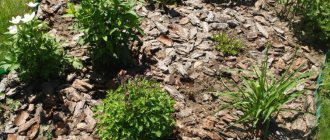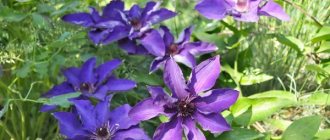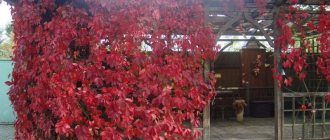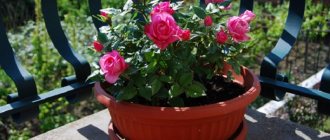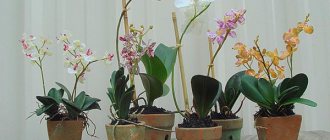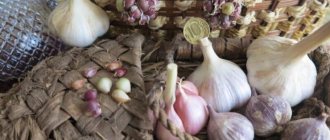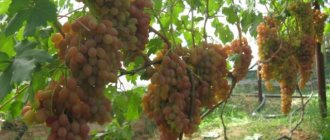Author: Natalya Category: Garden plants Published: June 22, 2018Republished: February 22, 2019Last edits: November 4, 2020
- Growing conditions
- Crown broom (Cytisus scoparius)
Broom (lat. Cytisus) is a genus of deciduous and evergreen trees and shrubs of the Legume family, growing on sandy loam and sandy soils of Europe, Western Asia and North America. According to various sources, there are from 30 to 70 species in the genus. The scientific name of broom comes from the place name of the island where it was first found. About 15 species of the genus are grown in garden culture. Many of them are used in landscape design, decoration, and some are used to strengthen sand slopes.
Planting and caring for broom
- Flowering: during the month from April-May to May-June.
- Planting: planting seedlings in the garden - from April to May.
- Lighting: bright sunlight.
- Soil: light, drained, sandy loam, neutral or slightly acidic.
- Watering: abundant as the top layer of soil dries.
- Feeding: from the beginning of active growth - with nitrogen fertilizers, from mid-summer - with potassium-phosphorus fertilizers.
- Pruning: After flowering, the branches are pruned to a strong lateral branch, without affecting the woody part.
- Reproduction: seeds, green cuttings and layering.
- Pests: moths, moths.
- Diseases: black spot and powdery mildew.
Read more about growing broom below.
Planting a hedge
To plant a broom hedge, you need to purchase or grow planting material. Buy three-year-old seedlings. The root system of the shrub is extremely sensitive; older plants will not tolerate planting.
Pay attention only to fairly developed bushes. The transplant will need to be done together with a lump of earth so as not to damage the rhizome. Before planting, the required number of seedlings is calculated.
The optimal planting time is spring. It is necessary to mark the area, stretch the line, and sprinkle with sawdust. Prepare a trench up to seventy centimeters deep. When planted in one row, the width is fifty centimeters.
Drainage, fertile layer, and nutrient mixture are placed in the trench. Acidic soil is enriched with lime. Shrubs are replanted with a ball of earth. The plant has a poorly developed root system that is easily damaged. Cover the rhizomes of the seedlings with a fertile layer. The distance between seedlings is left up to fifty centimeters. Watering is carried out. The soil is sprinkled with sawdust.
During the first year, they monitor watering and regularly feed the plants.
Botanical description
Brooms are shrubs or low trees from half a meter to three meters high. Trifoliate or reduced to one lobe leaves are arranged alternately on the branches and in some species are equipped with stipules. Sometimes both the branches and leaves of brooms are covered with grayish pubescence. The flowers, most often yellow, white, and sometimes pinkish, purple or bicolor, are collected at the ends of the shoots in racemes or heads. Almost all representatives of the genus are honey plants. Broom fruits are linear multi-seeded beans that crack when ripe and contain flat, kidney-shaped, shiny seeds.
What is broom
Broom is considered a crop from the Legume family and is presented as a shrub or tree. In nature, the plant can be found in European and North African countries, as well as in Western Asia. Broom thrives on light, dry, sandy soils.
The plant prefers well-lit areas, as it is considered light-loving.
Botanical description of broom:
- General characteristics . The plant may look like a lush shrub or a small tree. The height and width of broom may vary depending on the variety, reaching from 0.3 to 3 m.
- Leaf . This part of the plant is located alternately on the shoots. Most often they are trifoliate, less often single. Stipules are either very small or absent altogether. Color: bright green. The leaf lobes at the tops are often combined into one. The shape is oval. Length - about 3-4 cm. In winter they fall off, but some varieties are evergreen.
- Crown . The branched part is lush and spreading. Woody stems have rich green bark. Young branches are quite flexible. There are types of broom that have light gray patches on the bark. Wood - with scattered or ring-shaped vessels.
- Flower . The average size is 2-3 cm. It has various shades: yellow, white, pink, and purple. Usually the flowers are papilionaceous, collected in racemes and located on the edges of the shoots. The calyx is tubular or bell-shaped, 10–15 cm long. The flower has the appearance of a long sail, with wings and smaller boats.
- Fruits and seeds . The beans have a diameter of 2-3 cm and a sickle shape. Their color can be either brown or black. The beans contain grains. The seeds have a flattened shape and a glossy green or yellow coating. The average grain size is 33 mm.
Planting broom in open ground
When to plant
The broom bush is planted in open ground as seedlings with the onset of spring. The place for the plant should be sunny and protected from the wind, and the soil on the site should be slightly acidic (pH 6.5-7.5), well-drained, light and preferably sandy loam. Broom should not be planted near ponds with fish, as the plant contains toxic substances. To fill the planting pit, you need to prepare in advance a soil mixture consisting of one part turf soil, two parts sand and one part humus. Complete mineral fertilizer, for example, Kemiru-universal, is added to the prepared soil at the rate of 120 g per 1 m². Before planting, the nutritious earth mixture is thoroughly mixed.
In the photo: How broom blooms in the garden
How to plant
If you are planting several bushes, then maintain a distance of at least 30 cm between them. A hole is dug in volume twice as large as the root ball of the seedling. If the soil on the site is heavy, place a 20 cm thick layer of drainage material on the bottom of the pit, but if you grow broom in sandy soil, then the thickness of the drainage layer can be half as much.
- Daffodil bulbs
How to grow viburnum on the site
The seedling is placed in the center of the hole and the free space is gradually filled with nutritious soil mixture, lightly compacting it in the process. The root collar of the seedling is left at surface level. After planting, the tree trunk circle is watered abundantly, and when the water is absorbed, it is mulched with a layer of organic material 3-5 cm thick.
Application of broom
Broom can become a striking element of landscape design, acting as an original decoration for your garden. At the same time, different parts of the bush are often used in traditional medicine recipes.
In landscape design
Broom can be planted as a single plant or in various compositions. Brightly flowering bushes will decorate any garden, especially in early spring, when not all plants are ready to please with their flowering. Experts recommend planting medium-sized broom in parallel with large crops.
Important! Since this plant contains poisonous juice, it is not recommended to grow it near bodies of water where fish live.
This plant will look very impressive against the background of coniferous trees, as well as with representatives of heathers, lilies of the valley or lavender. Broom bushes are also suitable for creating hedges. Low-growing specimens are often planted on rocky hills, borders and to decorate sandy slopes. Many gardeners believe that the best neighbors for broom are juniper, heather and perennial flowers.
Caring for broom in the garden
Growing conditions
Planting broom and caring for it in open ground is no more difficult than cultivating any other garden shrub. Growing broom requires the usual procedures and activities for any gardener: watering, loosening the soil around the bush, weeding and mulching the root circle, fertilizing, pruning and preparing for wintering. A caring gardener, in addition to fulfilling the described points, will not forget about preventive treatments of broom against diseases and pests.
Watering and fertilizing
Watering the broom is carried out as the top soil layer dries, and the tree trunk circle of the plant is moistened abundantly. Hybrid brooms are more demanding of soil moisture than species brooms, but since this crop is generally drought-resistant, during the season with normal rainfall the shrub does not need to be watered, but in dry summers it should be moistened regularly. With the onset of autumn, watering is gradually reduced. Broom reacts negatively to lime in water, so the water should be allowed to settle before watering.
After watering or rain, it is advisable to loosen the soil in the trunk circle of each bush to a depth of 8-12 cm, while simultaneously removing weeds.
As for fertilizing, broom needs nitrogen in the spring, and potassium and phosphorus from mid-summer. Based on this, select fertilizers for it: in the spring, apply urea under the bushes at the rate of 30 g per 10 liters of water, and before flowering, for feeding, dissolve 30 g of potassium sulfate and 60 g of superphosphate in the same amount of water. If it seems to you that the broom is not developing quickly enough, carry out a third feeding, scattering 300 g of ash under each bush.
In the photo: Growing broom in the garden
Transfer
Transplanting broom from one place to another is carried out in the same order as the initial planting: first you need to dig a pit with a volume approximately twice the size of the root system of the transplanted bush, then lay drainage on the bottom; fertile soil prepared for filling the planting hole should be mixed with fertilizers, and only after that the bush intended for replanting is dug up, moved to the new planting site, the root ball is lowered into the hole and planting is completed as described in the corresponding section.
Reproduction
Broom propagates by seeds, layering and green cuttings. Broom seeds are collected from ripened beans in August-September and sown to a depth of 5-6 mm in a substrate composed of sand and peat in equal parts, after which the crops are covered with film. Germinate the seeds at a temperature of 19-21 ºC in the shade, spraying and ventilating from time to time. At the stage of development of 1-2 true leaves, the seedlings dive into a substrate consisting of two parts of turf soil, one part of sand and one part of humus and laid out in pots with a diameter of 7 cm. In the spring, the seedlings are transplanted into large pots - with a diameter of 11 cm - and pinched for strengthening branching. Young brooms 30-55 cm high are planted in open ground in the third year.
In the photo: How the broom bush blooms
To make cuttings, in the summer you need to cut semi-lignified shoots with 2-3 leaves from an adult plant, shorten the leaf blades by half and plant the cuttings in a mixture of peat and sand under a transparent cap. Rooting occurs at a temperature of 18-20 ºC, while the cuttings are regularly ventilated and the substrate is sprayed with a sprayer. After one or a month and a half, the rooted cuttings are planted in pots with a diameter of 8-9 cm and grown until they are two years old, after which they are transplanted to a permanent place.
To propagate broom by layering in the spring, select the lowest branches on the bush, place them in grooves made in the ground, pin them down and cover them with soil. During the season, the cuttings are watered and fed simultaneously with the mother bush, they are well protected from frost for the winter, and in the spring they are separated and planted.
How to plant and grow rowan in the garden
Broom in winter
After flowering, broom branches are pruned to strong lateral branches, and it is very important that the woody part is not affected. With the onset of cold weather, young plants that have not reached three years of age need to be covered for the winter, since the winter hardiness of broom appears only in adulthood. The bush is hilled high with dry soil or peat, then the branches of the plant are carefully pulled together, tied, gradually bent to the ground and secured in this position. The bushes are covered with dry leaves, spruce paws or non-woven covering material, the edges of which are pressed to the ground with stones.
Adult plants endure winter without shelter.
Features of care
The shrub tolerates drought and copes with flooding. Watering is done after the soil surface has dried. Spraying is carried out in hot weather.
After flowering, it is recommended to perform molding pruning. In the first years, the plant needs shelter in winter. Grown plants are pressed to the ground, covered with leaves and branches. An adult shrub tolerates low temperatures without shelter.
The plant requires special attention in the first years after planting. It is necessary to provide high-quality fertilizing. Nutrient mixtures are applied at least three times a year. Before flowering, after flowering, end of summer. It is important to provide watering during dry periods. In spring and autumn, the plant does not need abundant watering. In the first years, even frost-resistant species need shelter. You can use branches and foliage. Carefully twist the branches of the bush and press them to the ground.
Only three-year-old shrubs can be used for planting. Younger seedlings will not take root; older ones do not tolerate planting well. Even large shrubs have an underdeveloped root system. It needs to be taken into account in frosty years. It is necessary to cover the ground between the bushes to protect the root system.
The plant responds well to nutrients. Fertilizing can significantly improve external qualities, prolong flowering, and make it more abundant.
Avoid planting in open areas. The first years of life, drafts pose a serious danger.
Pests and diseases
Brooms are generally resistant to diseases and pests, but can be affected by moths and moths. At the first signs of a plant being occupied by moths, it should be treated with Chlorophos solution. For moths, the shrub is treated with bacterial insecticides.
Of the diseases, the most dangerous for broom are black spot and powdery mildew, which covers its leaves and stems with a whitish, sloppy coating. To combat powdery mildew, broom is sprayed in early spring, before sap flow begins, with a five percent solution of copper sulfate, and in the summer, for preventive purposes and to destroy infection, the bushes are alternately treated with colloidal sulfur, Fundazol solution and copper-soap liquid. The causative agents of black spot are destroyed in early spring with a solution of copper or iron sulfate, and in the summer drugs such as copper oxychloride, Fundazol, Captan, Bordeaux mixture or any other fungicide of a similar effect can help cope with the disease. A solution for treating shrubs on leaves is prepared in accordance with the instructions.
- Korostavnik: cultivation, properties and application
Features of growing in the Moscow region
Broom is unpretentious in care and cultivation, but residents of the Moscow region who want to own this exotic shrub should follow several tips:
- It is recommended to plant frost-resistant varieties;
- be sure to insulate the plant for the winter;
- water abundantly;
- plant shrubs in places that are lit and protected from the wind;
- Regularly feed the plants and loosen the soil.
Important! Broom contains medicinal and toxic substances in all parts, therefore, when preparing medicines based on it, you must strictly adhere to the dosages.
Types and varieties
Broom is often found in garden culture, but some of its species are especially popular.
Crown broom (Cytisus scoparius)
The plant is native to Southern and Central Europe. The bush reaches a height of 3 m, its thin green shoots are pubescent at a young age; leaves petiolate, alternate, trifoliate. The leaf lobes are obtuse, oval or oblong-lanceolate, entire. The upper leaves often consist of a single leaflet. Irregular light yellow flowers, formed singly or in pairs in the leaf axils, are located on a pubescent peduncle. The fruit of the plant is a flattened, long and narrow bean with seeds. The plant has been in cultivation for a very long time. It has many decorative forms, which, unfortunately, can only be grown in regions with warm winters:
- Burkwoodii - broom with red-scarlet flowers with a yellow border;
- Killiney Red is a plant with bright red flowers;
- Andreanus Splendens is a shrub with yellow and scarlet flowers.
In the photo: Crown broom (Cytisus scoparius)
Creeping broom (Cytisus decumbens)
It is found in the wild in southern Europe: it descended from the light pine forests of the Dalmatian Mountains. This is a prostrate shrub up to 20 cm high and up to 80 cm in diameter. It has green, pubescent, five-ribed shoots that take root very easily, and oblong-lanceolate dark green leaves, pubescent at the bottom, up to 2 cm long. Yellow flowers up to one and a half centimeters long are arranged one or a few in leaf axils. The species has been in cultivation since 1775. Creeping broom is winter-hardy, but can freeze in very cold weather.
In the photo: Creeping broom (Cytisus decumbens)
Early broom (Cytisus praecox)
This is an unpretentious plant up to one and a half meters high with spreading arched thin branches forming a dense crown; leaves are narrow, lanceolate, light green, up to 2 cm long; The root system is superficial. The bright yellow flowers abundantly covering the bush have a pungent odor. This species is frost-resistant. The most famous varieties:
- Olgold is a broom with bright yellow flowers that open before the leaves appear;
- Boskop Ruby broom is a shrub up to 2 m high with oblong-lanceolate leaves and ruby-colored flowers on the outside, colored mauve on the inside.
In the photo: Early broom (Cytisus praecox)
Crowded broom (Cytisus aggregatus)
An interesting dwarf species from Eastern Europe. It reaches a height of 30 to 50 cm, and the bush is about 80 cm in diameter. The plant blooms and bears fruit from the age of three. Its flowers are bright yellow. Frost resistance is good, but sometimes the ends of the shoots can freeze.
Sessile broom (Cytisus sessilifolius)
This is a plant from Western Europe up to one and a half meters high with trifoliate leaves and bright yellow flowers up to 1.5 cm long, formed on shortened peduncles. The winter hardiness of this species is low: shoots freeze above the snow cover, so with the onset of cold weather the plant needs shelter.
In the photo: Sessile broom (Cytisus sessilifolius)
Black broom (Cytisus nigricans = Lembotropis nigricans)
Grows in Belarus, Ukraine, the European part of Russia and Western Europe. The plant received this name because its leaves turn black when dried. The shrub grows up to 1 m in height, its shoots are covered with short, pressed hairs. Golden-yellow flowers are formed in 15-30 pieces in a vertical spike-shaped inflorescence at the ends of the shoots. Black broom is very attractive during the flowering period.
In the photo: Black broom (Cytisus nigricans = Lembotropis nigricans)
Zinger's broom (Cytisus zingerii)
Inhabits mixed forests in the upper reaches of the Dnieper. It reaches a height of 1 m, young shoots have golden pubescence and light green trifoliate leaves, and during the flowering period, when yellow flowers appear from each axil, the shoots look like golden ears. Unfortunately, this species is still rarely found in culture.
Gardeners are also known to oblong (or elongated), protruding (or edge-flowered, or floating-flowered) and kyus brooms.
Brooms are also called representatives of the related genus Broom (Chamaecytisus), which can often be found in gardens.
Russian broom (Chamaecytisus ruthenicus = Cytisus ruthenicus)
This is a deciduous shrub up to one and a half meters high with curving branches covered with gray bark. The shoots of the plant are covered with silky hair; leaves are trifoliate, consisting of lanceolate-elliptic leaflets up to 2 cm long with a spine at the apex. The leaves are grayish-green above and covered with dense pubescence below. The flowers of Russian broom are yellow, up to 3 cm long, they are formed in the axils of the leaves in groups of 3-5 and bloom for about four weeks. The species is easy to care for and drought-resistant.
In the photo: Russian broom (Chamaecytisus ruthenicus = Cytisus ruthenicus)
Purple broom (Chamaecytisus purpureus = Cytisus purpureus)
Descended from the mountains of Central and Southern Europe. This is a creeping plant up to 60 cm high with a spreading crown and ascending branches, densely covered with trifoliate leaves with broadly elliptical lobes. The species is distinguished by its rapid growth. In winter it freezes heavily, but recovers well. Purple broom has a highly decorative variety:
- Atropurpurea is a spreading shrub with purple-pink flowers. The hybrid Golden Rain broom, also called Adam's broom, is also popular.
The following varieties of purple broom are also in demand:
- Albus broom is a shrub up to 45 cm high with white flowers. The variety was bred in 1838;
- Roseus is a plant with pink flowers;
- Albocarneus - a variety with pale pink flowers;
- Amzaticus - broom with purple-blue flowers;
- Eloganthus - a variety with hanging shoots and purple-red flowers;
- Plena - broom with double flowers;
- Depressa is a dwarf variety up to 20 cm high with very small leaves and fruits.
In the photo: Purple broom (Chamaecytisus purpureus = Cytisus purpureus)
Regensburg broom (Chamaecytisus ratisbonensis = Cytisus ratisbonensis)
Found naturally in the Dnieper basin. This is a prostrate plant up to 30 cm high with trifoliate leaves and shoots silvery with pubescence. The flowers of the Regensburg broom are bright yellow. The following garden form is popular:
- Dicentra: growing from seeds, types and varieties
- Biflorus is a plant with silvery-pubescent leaves when young. In general, the species is resistant to both drought and frost, therefore it is found in gardens from the middle zone all the way to Novosibirsk. The species was introduced into culture in 1800.
In the photo: Regensburg broom (Chamaecytisus ratisbonensis = Cytisus ratisbonensis)
In addition to the described species, the following brooms of the Rakitnichek genus are popular: Roshal, Podolsky, recumbent, bare elongated and Blotsky. And the plant, familiar to readers as the golden broom, is not exactly a broom: it is anagyroid or anagyrofolia, or Golden Rain - a species of the genus Bobovnik.
Reproduction
Broom can be propagated in 3 ways:
- seeds;
- cuttings;
- layering.
Seeds for propagation are collected at the end of August or beginning of September, when the beans are fully ripened. They are planted in a container, covered with film and placed in a warm place with a temperature of up to 20 C°. Periodically, the seedlings are opened, ventilated and sprayed. The grown seedlings are transplanted to a permanent place in open ground no earlier than after 3 years.
Cuttings are carried out after the end of flowering using semi-woody shoots, which should have at least 3-4 full leaves of medium size. They are trimmed and planted in a container. Each cutting is covered with a glass jar; during rooting, ventilation and spraying are mandatory. In spring, rooted cuttings are transplanted into open ground.
Propagation by layering is performed by bending the branches of the lower part of the bush to the ground. The tops of the branches that touch the soil are secured with special staples, then they are sprinkled with earth. When the cuttings begin to take root, they should be cut off, separated from the mother bush, and transplanted to another place.
Application in landscape design
Broom is very famous among landscape designers. It looks great both in solitaire plantings and in numerous compositions . Experienced specialists combine it with conifers, heather, lilies of the valley, lavender, and other cereal plants. This ornamental crop also makes excellent hedges.
Did you know? The highest variety of broom is Moroccan. It grows up to 5 m, and its flowers smell like pineapple.
Broom is a very simple plant with a gorgeous, picturesque crown and a long flowering period. Everyone who sees it at least once will not remain indifferent and will want to plant this beautiful and spreading ornamental bush in their garden.
